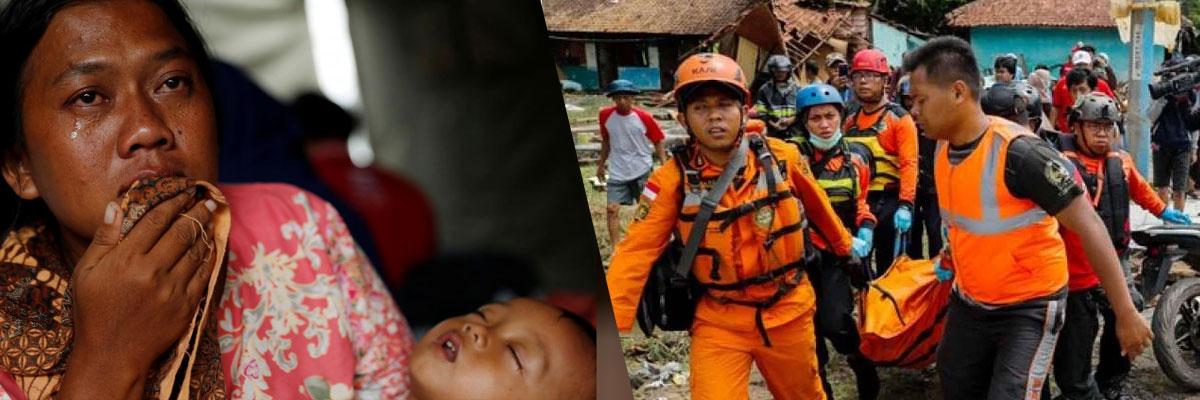Indonesian rescuers use drones, sniffer dogs as tsunami death toll rises

Indonesian rescuers on Tuesday used drones and sniffer dogs to search for survivors along the devastated west coast of Java hit by a series of tsunamis that killed at least 373 people, warning more victims are expected to be uncovered as the search expands
LABUAN, Indonesia: Indonesian rescuers on Tuesday used drones and sniffer dogs to search for survivors along the devastated west coast of Java hit by a series of tsunamis that killed at least 373 people, warning more victims are expected to be uncovered as the search expands.
Thick ash clouds continued to spew from Anak Krakatau, a volcanic island where a crater collapse at high tide on Saturday sending tsunamis smashing into coastal areas on both sides of the Sunda Strait between the islands of Sumatra and Java.
At least 128 people remain missing. More than 1,400 people were injured, and thousands of residents had to move to higher ground, with a high-tide warning extended to Wednesday.
Rescuers used heavy machinery, sniffer dogs, and special cameras to detect and dig bodies out of mud and wreckage along a 100 km (60 mile) stretch of Java’s west coast and officials said the search area would be expanded further south.
“There are several locations that we previously thought were not affected,” said Yusuf Latif, spokesman for the national search and rescue agency.
“But now we are reaching more remote areas...and in fact there are many victims there,” he added.
The vast archipelago, which sits on the Pacific “Ring of Fire”, has suffered its worst annual death toll from disasters in more than a decade.
Earthquakes flattened parts of the island of Lombok in July and August, and a double quake-and-tsunami killed more than 2,000 people on a remote part of Sulawesi island in September.
“At least 373 people have died, while 128 people are currently missing,” Sutopo Purwo Nugroho, a spokesman for the disaster mitigation agency, said on Monday evening.
It took just 24 minutes after the landslide for waves to hit land, and there was no early warning for those living on the coast.
“EVERYTHING IS DESTROYED”
Authorities and experts have warned of further high waves and advised residents to stay away from the shoreline.
“Since Anak Krakatau has been actively erupting for the past several months additional tsunamis cannot be excluded,” said Dr. Prof Hermann Fritz, from the Georgia Institute of Technology in the United States.
Rescue efforts were hampered by heavy rainfall and low visibility. Military and volunteer rescue teams used drones to assess the extent of the damage. One team used sniffer dogs to search for survivors at the beach club where a tsunami washed away an outdoor stage where the Indonesian rock band Seventeen were performing at a party for about 200 guests.
Destruction was visible along much of the coastline where waves of up to two meters (six feet) crushed vehicles, lifted chunks of metal, felled trees, wooden beams and household items and deposited them on roads and rice fields.
Nurjana, 20, ran uphill after the tsunami hit. Her beachside snack stall was washed away.
“I opened the door straight away and saved myself. I jumped over the wall,” she said. “Everything is destroyed.”
Out in the strait, Anak Krakatau (Child of Krakatau) was still erupting, belching white smoke and ash into the sky.
The meteorology agency said that an area of about 64 hectares, or 90 soccer pitches, of the volcanic island had collapsed into the sea.
In 1883, the volcano then known as Krakatoa erupted in one of the biggest blasts in recorded history, killing more than 36,000 people in a series of tsunami, and lowering the global surface temperature by one degree Celsius with its ash. Anak Krakatau is the island that emerged from the area in 1927, and has been growing ever since.
Saturday’s high waves isolated hundreds of people on Sebesi island, about 12 km (seven miles) volcano.
“We are completely paralyzed,” Syamsiar, a village secretary on the island, told Metro TV, calling for food and medicine.
President Joko Widodo, who is running for re-election in April, told disaster agencies to install early warning systems, but experts said that, unlike tsunami caused by earthquakes, little could have been done in time to alert people that waves were coming.
MEMORIES OF 2004
“Tsunamis from volcanic flank collapse are generated right at the coast and often close to populations,” said Eddie Dempsey, lecturer in structural geology at Britain’s University of Hull.
“The interval between the volcanic collapse and the arrival of the waves is minimal.”
The timing of the disaster over the Christmas season evoked memories of the Indian Ocean tsunami triggered by an earthquake on Dec. 26, 2004, which killed 226,000 people in 14 countries, including more than 120,000 in Indonesia.
Food, water, blankets, and medical aid has started arriving in the area.
District chief Atmadja Suhara said he was helping to care for 4,000 refugees, many of them homeless.
“Everybody is still in a state of panic,” he said. “We often have disasters, but not as bad as this.”
“God willing,” he said, “we will rebuild.”




















